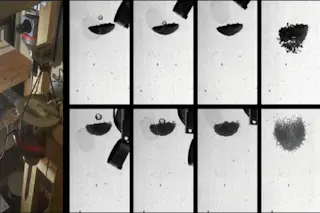(Left) Picture of the laboratory drop tower. (Right) The expansion of granular clusters from impact. (Credit: Hiroaki Katsuragi and Jürgen Blum) By firing plastic, lead and glass projectiles into clumps of dust, researchers are improving our understanding of how planets form in the universe. Planets start out as loose clumps of dust grains. And, like flour clumps up as you mix it into cake batter, cosmic dust clumps eventually build up to become planets like Earth as gravity pulls them together. But there's still much to be understood about this process. So, to investigate some of the dynamics behind this process, researchers shot projectiles into clumps of free falling dust.
As planets form, they often collide with other matter and objects around them. So, understanding how the dust clumps that one day become planets react to impacts is key to creating a realistic planetary-formation model, the researchers say in a ...














